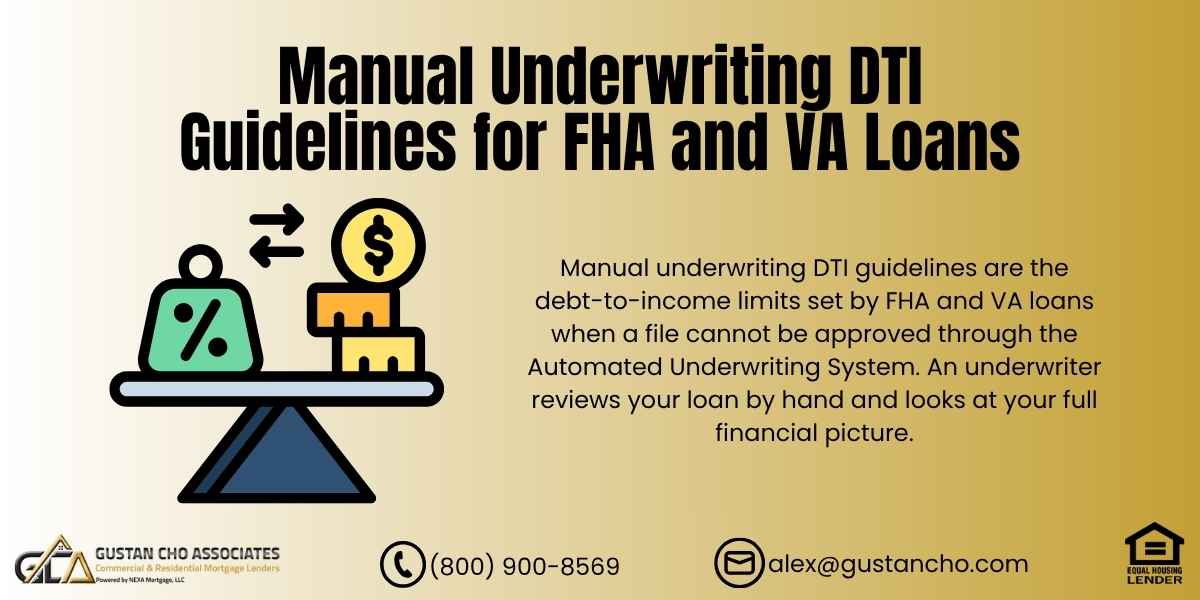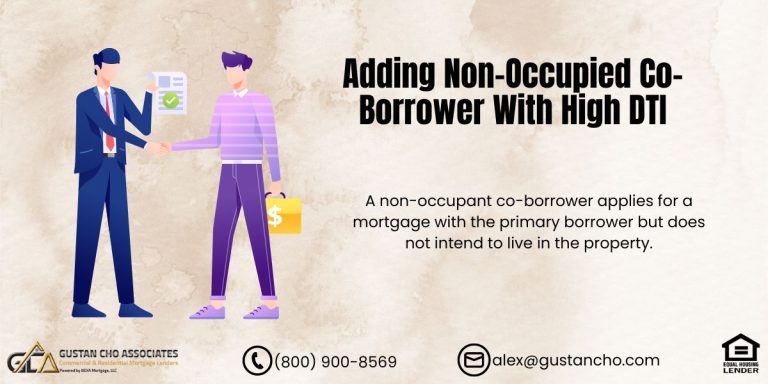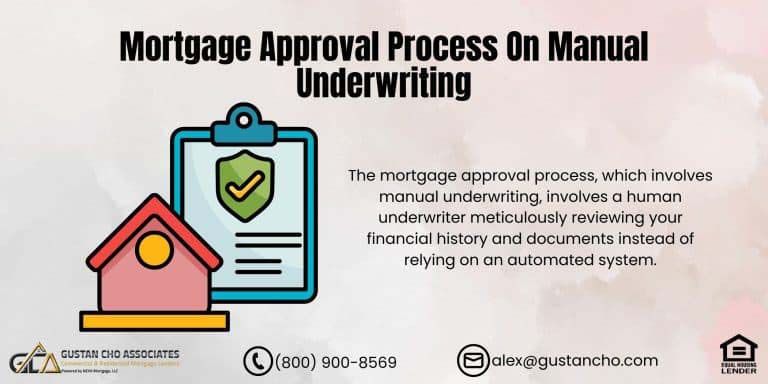This guide covers manual underwriting DTI guidelines on FHA and VA loans. HUD and the Veterans Administration are the only two mortgage agencies that allow manual underwriting on home loans. Debt-to-income ratios is one of the most important factors when it comes to qualifying for a mortgage loan. Every mortgage loan program has its own set of guidelines when it comes to debt-to- income ratio requirements. For example, conventional loans have a debt-to-income ratio cap at 50% DTI.
To get an approve/eligible per Automated Underwriting System on FHA loans, the maximum front-end debt-to-income ratio is capped at 46.9% DTI and the maximum back-end debt-to-income ratios are capped at 56.9%.
If borrowers applying for FHA loans have credit scores under 620, the maximum debt-to-income is capped at 43% DTI to get an approve/eligible per Automated Underwriting System. There are loan applicants who cannot get an approve/eligible per Automated Underwriting System because the automated system cannot render a decision and will render a refer/eligible. What a refer/eligible means is that the mortgage loan applicant is eligible for an FHA loan. However, the automated system cannot approve the mortgage loan. We will discuss and cover more on manual underwriting DTI guidelines and compensating factors in the following paragraphs.
What Does Refer/Eligible Per Automated Underwriting System Mean?
[embedy]https://youtu.be/RQVLs9jpEEQ[/embedyt]
In cases where the automated system yields a refer/eligible, the applicant may be eligible for manual underwriting. Manual underwriting is where a mortgage underwriter needs to manually underwrite the loan application and review the whole file and render its decision. There is no debt to income ratio requirements with manual underwriting. However, the mortgage underwriter will thoroughly review the layers of risk the mortgage file has and will especially look for compensating factors. Compensating factors are extremely important in manual underwriting applications. Speak With our expert to know more about underwriting applications
What Are Compensating Factors For Manual Underwriting DTI Guidelines
Compensating factors are crucial for borrowers who have higher debt-to-income ratio on FHA and VA loans. Compensating factors are positive factors that show strength on the mortgage borrowers such as low payment shock through the following positive factors:
- verification of rent
- reserves
- longevity on the job
- part-time or other income that the borrower has but is not used to qualify for the mortgage loan
- the working spouse who is not added to the loan
- other positive factors
Per HUD and VA Manual Underwriting DTI Guidelines, as of 2005, it is the number of compensating factors that determine how high the debt-to-income ratio is capped. Mortgage underwriters have a great deal of underwriter discretion on manual underwrites. Therefore, if the mortgage underwriter sees strong compensating factors, the underwriter can surpass the maximum recommended FHA and VA manual underwriting guidelines.
FHA Manual Underwriting DTI Guidelines in 2025

When a loan is downgraded to manual underwriting, HUD sets maximum debt-to-income (DTI) ratios depending on how many compensating factors the borrower has. This gives underwriters the flexibility to approve borrowers with strong financial stability, even if their DTI exceeds the standard limit.
Here are the FHA manual underwriting tiers as of 2025:
31/43 with No Compensating Factors
-
- Housing ratio capped at 31%
- Total debt ratio capped at 43%
37/47 with One Compensating Factor
-
-
- Housing ratio capped at 37%
- Total debt ratio capped at 47%
-
40/50 with Two or More Compensating Factors
-
- Housing ratio capped at 40%
- Total debt ratio capped at 50%
A borrower with strong reserves, solid rent history, and job stability may qualify with up to a 50% back-end DTI, even when their AUS findings only return a refer/eligible.
FHA Manual Underwriting DTI Limits (2025)
| Compensating Factors | Max Front-End DTI | Max Back-End DTI |
|---|---|---|
| None | 31% | 43% |
| One | 37% | 47% |
| Two or More | 40% | 50% |
As shown above, the stronger your compensating factors, the higher your allowable DTI under manual underwriting — up to 40/50.
How Do Underwriters Evaluate Manual Underwriting DTI Guidelines
How do underwriters evaluate manual underwriting guidelines for debt-to-income ratio is a question I get asked often. Not all lenders will do manual underwriting. Manual underwriting is needed on files that cannot get an approve/eligible per the Automated Underwriting System. For example, all applicants who had a Chapter 13 Bankruptcy discharged. If the discharged date has not been seasoned for at least two years, borrowers can qualify for an FHA loan. But will not get an approve/eligible per Automated Underwriting System if the discharge has not been seasoned two years from the discharge date.
Manual Underwriting DTI Guidelines For Chapter 13 Bankruptcy
I recently got a borrower who just had a Chapter 13 Bankruptcy discharged less than a year ago that got a refer/eligible per Automated Underwriting System:
- Got them approved via a manual underwrite per manual underwriting DTI guidelines.
- However, the back end debt-to-income ratios were 52% which is considered extremely high for manual underwriting.
- The manual underwriting underwriter approved this file because this client had a lot of compensating factors
- The borrower had two full-time jobs
- But could only use one of the full-time jobs as income
- This is because she did not have two-year seasoning with her second full-time job as a nurse
- The borrower had plenty of reserves
- Not just in her bank accounts, but also had a hefty 401k
- The borrower has been in the nursing field for over 10 years
- Has been with the same employer without any gaps in employment in the past 2 years
- The borrower has verification of rent, which is mandatory on all manual underwriting
- The borrower has paid all of her bills on time during the Chapter 13 Bankruptcy re-payment plan
- Has not had a late payment since her Chapter 13 Bankruptcy discharge date
- In this particular case scenario, there was no debt-to-income ratio requirements with manual underwriting due to the many compensating factors
The mortgage underwriter saw on this file and approved her with a 52% back-end debt-to-income ratio. Click here to get approve with 52% back-end DTI
How a Borrower Qualified With Manual Underwriting DTI Guidelines
At Gustan Cho Associates, we often work with homebuyers who are denied by other lenders because of strict debt-to-income ratio rules. One of our recent clients, Maria, left us a review after her successful closing that shows how manual underwriting made the difference.
Maria came to us after being turned down by two banks. Her AUS findings kept coming back as refer/eligible because her credit score was 605, and her back-end DTI was 48%. Most lenders told her she didn’t qualify.
Here’s how our team helped her:
Compensating Factors That Made the Difference
- Maria had a spotless 12-month rental history with checks and bank statements to prove on-time payments.
- She saved over four months of reserves between her checking account and retirement funds.
- She worked as a teacher for over seven years with the same school district, showing job stability.
- Her payment shock was low because her new mortgage was only $150 more than what she was already paying in rent.
The Result
- Because she had strong compensating factors, we were able to approve her FHA loan through manual underwriting at a 48% back-end DTI. She and her family closed on their first home, something she thought would never happen after being denied elsewhere.
Maria’s review said it best:
I thought homeownership was impossible after being denied twice. Gustan Cho Associates not only explained the process but fought for my approval with manual underwriting. Today, I’m holding the keys to my first home. Thank you for not giving up on me!
Manual Underwriting Guidelines on Verification of Rent
Many folks who rent do not realize the importance of paying their rental payments with a check. Many renters pay their monthly rental payments on time, month after month, year after year, but do not pay it with a check or online and pay it with cash. Any cash rental payment will not count for verification of rent. Verification of rent is one of the most important compensating factors a borrower can have and verification of rent is a requirement on all manual underwriting.
The only way verification of rent can be proven is by providing 12 months canceled checks or 12 months bank statements if the rental payments were wired to the landlord and paid online.
If the renter has been renting from a registered property management company, then verification of rent form signed by the property management manager can be used in lieu of canceled checks or online bank statements. Verification of rent is also required for mortgage loan applicants with credit scores of under 600.
Verfication of Rent on Manual Underwriting DTI Guidelines
Reason verification of rent is so important is lenders want to determine payment shock. For example, if you are living rent-free with family and are used to paying no rent and new housing payment will be $1,200, that is a huge payment shock However, if renters are currently paying $1,000 per month in rent and new housing payment will be $1,100, then your payment shock of $100 per month or 10% should be no issue.
Manual Underwriting DTI Guidelines Versus Lender Overlays
Homebuyers who told they do not qualify for a home loan by another lender because they do not meet debt to income ratio requirements with manual underwriting or lender do not do manual underwriting or have many mortgage lender overlays please contact us at Gustan Cho Associates at 1-800-900-8569 or text us for faster response.
Gustan Cho Associates will waive verification of rent for borrowers who have been living rent-free with family members to save money for the down payment and closing costs on a home purchase.
Borrowers can also email us at gcho@gustancho.com. The team at Gustan Cho Associates is available 7 days a week, on evenings, weekends, and holidays to answer all of your questions and issue pre-approval letters. We are a full-service mortgage company licensed in multiple states with no lender overlays. We have zero overlays on FHA loans and just follow HUD 4000.1 FHA Handbook Guidelines.
Related> Verification of Rent for Manual Underwriting
Frequently Asked Questions About Manual Underwriting DTI Guidelines:
Q: What are the Manual Underwriting DTI Guidelines?
A: Manual underwriting DTI guidelines are the debt-to-income limits set by FHA and VA loans when a file cannot be approved through the Automated Underwriting System. An underwriter reviews your loan by hand and looks at your full financial picture.
Q: What is the Maximum DTI Allowed with Manual underwriting?
A: Per HUD, the max ratios are 31/43 with no compensating factors, 37/47 with one compensating factor, and 40/50 with two or more compensating factors.
Q: Do VA Loans Follow the Same Manual Underwriting DTI Guidelines as FHA?
A: Not exactly. VA loans don’t have hard DTI caps like FHA. Instead, VA looks at your residual income and overall risk. However, manual underwriting still applies when AUS gives a refer/eligible.
Q: Can I Get Approved if My DTI is Over 50% with Manual Underwriting?
A: It’s rare, but possible in exceptional cases with very strong compensating factors. Most lenders follow HUD’s 40/50 rule.
Q: What are Compensating Factors in Manual Underwriting DTI Guidelines?
A: Compensating factors are positives that strengthen your file, like solid rental history, job stability, cash reserves, or low payment shock. The more you have, the higher DTI you can qualify with.
Q: Why Would My Loan Need Manual Underwriting in the First Place?
A: Usually, because the Automated Underwriting System gave you a refer/eligible instead of an approval. This happens if you have a recent bankruptcy, lower credit scores, or other risk factors.
Q: Does Every Lender Follow HUD’s Manual Underwriting DTI Guidelines?
A: No. Many lenders add extra rules called overlays. At Gustan Cho Associates, we do not have overlays; we just follow HUD and VA guidelines.
Q: Is Verification of Rent Required Under the Manual Underwriting DTI Guidelines?
A: Yes. Lenders want proof that you pay rent on time. You’ll need 12 months of checks, bank statements, or a property management letter.
Q: Can I Still Get a Mortgage After Chapter 13 with Manual Underwriting?
A: Yes. FHA and VA allow manual underwriting after a Chapter 13 bankruptcy, even if it was recently discharged, as long as you meet the DTI guidelines and have compensating factors.
Q: Who Can Help Me if I was Denied Because of DTI Ratios?
A: If another lender told you no, contact Gustan Cho Associates. We specialize in helping borrowers qualify under manual underwriting DTI guidelines with no overlays.
This article about “Manual Underwriting DTI Guidelines for FHA and VA Loans” was updated on October 2nd, 2025.








